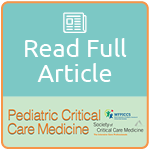Objectives
Placement of a ventricular assist device (VAD) improves outcomes in children with advanced heart failure, but adverse events remain important consequences. Preoperative mechanical ventilation (MV) increases mortality, but it is unknown what impact prolonged postoperative MV has.
Design
Advanced Cardiac Therapies Improving Outcomes Network (ACTION) and Pediatric Cardiac Critical Care Consortium (PC4) registries were used to identify and link children with initial VAD placement admitted to the cardiac ICU (CICU) from August 2014 to July 2020. Demographics, cardiac diagnosis, preoperative and postoperative CICU courses, and outcomes were compiled. Univariable and multivariable statistics assessed association of patient factors with prolonged postoperative MV. Multivariable logistic regression sought independent associations with outcomes.
Setting
Thirty-five pediatric CICUs across the United States and Canada.
Patients
Children on VADs included in both registries.
Interventions
None.
Measurements and Main Results
Two hundred forty-eight ACTION subjects were linked to a matching patient in PC4. Median (interquartile) age 7.7 years (1.5–15.5 yr), weight 21.3 kg (9.1–58 kg), and 56% male. Primary diagnosis was congenital heart disease (CHD) in 35%. Pre-VAD explanatory variables independently associated with prolonged postoperative MV included: age (incidence rate ratio [IRR], 0.95; 95% CI, 0.93–0.96; p < 0.01); preoperative MV within 48 hours (IRR, 2.76; 95% CI, 1.59–4.79; p < 0.01), 2–7 days (IRR, 1.82; 95% CI, 1.15–2.89; p = 0.011), and greater than 7 days before VAD implant (IRR, 2.35; 95% CI, 1.62–3.4; p < 0.01); and CHD (IRR, 1.96; 95% CI, 1.48–2.59; p < 0.01). Each additional day of postoperative MV was associated with greater odds of mortality (odds ratio [OR], 1.09 per day; p < 0.01) in the full cohort. We identified an associated greater odds of mortality in the 102 patients with intracorporeal devices (OR, 1.24; 95% CI, 1.04–1.48; p = 0.014), but not paracorporeal devices (77 patients; OR, 1.04; 95% CI, 0.99–1.09; p = 0.115).
Conclusions
Prolonged MV after VAD placement is associated with greater odds of mortality in intracorporeal devices, which may indicate inadequacy of cardiopulmonary support in this group. This linkage provides a platform for future analyses in this population.
This ACTION study was published in Pediatric Critical Care Medicine on April 15, 2024. Congratulations to the authors:
- Tanya Perry, DO
- David N. Rosenthal, MD
- Angela Lorts, MD, MBA
- Farhan Zafar, MD
- Wenying Zhang, MS
- Christina VanderPluym, MD
- Aaron G. Dewitt, MD
- Garrett Reichle, MD
- Mousumi Banerjee, PhD
- Kurt R. Schumacher, MD
CITATION
Perry, Tanya DO; Rosenthal, David N. MD; Lorts, Angela MD, MBA; Zafar, Farhan MD; Zhang, Wenying MS; VanderPluym, Christina MD; Dewitt, Aaron G. MD; Reichle, Garrett MD; Banerjee, Mousumi PhD; Schumacher, Kurt R. MD. Mechanical Ventilation and Outcomes of Children Who Undergo Ventricular Assist Device Placement: 2014–2020 Linked Analysis From the Advanced Cardiac Therapies Improving Outcomes Network and Pediatric Cardiac Critical Care Consortium Registries. Pediatric Critical Care Medicine ():10.1097/PCC.0000000000003520, April 15, 2024. | DOI: 10.1097/PCC.0000000000003520
